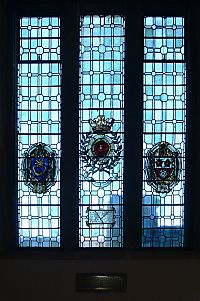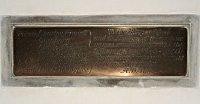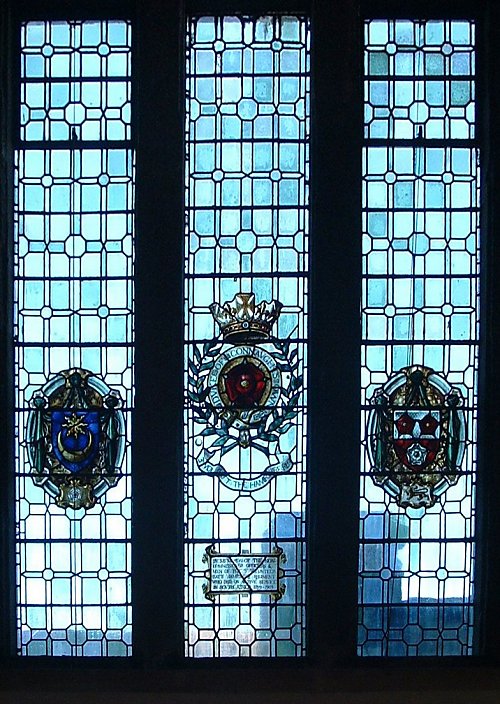Location
The window is in the north wall of the Quire (see Cathedral Plan).
COMMISSIONED OFFICERS &
MEN OF THE 3rd VOLUNTEER
Batt: HAMPSHIRE REGIMENT
WHO DIED
IN ACTIVE SERVICE
IN SOUTH AFRICA 1899/1903.
Inscription (Brass Plaque)
PRIVATE GUY FORD
PRIVATE CHARLES HODGKINS
PRIVATE WILLIAM JACKSON
L.Corpl WILLIAM MOODY
PRIVATE ERNEST R.WRIGHTON
__________________________
TO THE GLORY OF GOD
AND IN MEMORY OF THOSE WHOSE
NAMES ARE HERE ENGRAVED, THE
OFFICERS & MEN OF THE 3rd (D.C.O.)
VOLUNTEER Batt. HAMPSHIRE REGIMENT
DEDICATE THIS WINDOW
AD 1904.
Further Information
"The centre light contains the badge of the 3rd. (Volunteer) Battalion of the Hampshire Regiment. There is the Hampshire Rose surrounded by laurel branches. The legend that John of Gaunt gave the rose symbol to the county has been discounted by the Richmond Herald at the College of Arms. Roses certainly have royal connections and were used by the town of Southampton on a 14th-century staple seal, but the fact is that the Hampshire Rose, more usually red though sometimes white, has no official standing in heraldry as the badge of the county.
The Volunteers came into being as a result of the war scare of 1859 when Anglo-French relations were very strained. They provided their own arms and equipment and served at their own cost, except if called out for actual service. They were under the lords lieutenant of counties who authorised the formation of corps and gave commissions to their officers. Their purpose was to act as auxiliaries to the regular army and militia.
In the early part of the South African War the War Office gave notice that active service companies from volunteer battalions would be sent out to their county regiments at the front. The Hampshire Volunteer Infantry Brigade was called upon to supply one company, each battalion contributing a section of 23 rank and file. The first company under Captain Seward served in South Africa some 15 or 16 months, losing the six young men whose names appear on a brass plate. Four of them died of enteric fever and the other two in the Barberton railway accident.
In the right-hand light is the escutcheon of the borough of Southampton granted to it in 1575. This was no doubt included in the window because Southampton contributed a considerable number of recruits to the battalion and many of these served in South Africa.
Beneath the Portsmouth shield is a rose and below the Southampton one a tiger. This is a reference to the Hampshire Regiment, telling us something of the long history of the regiment, which was formed from the 37th and 67th of the Line, dating from 1702. In 1782 the line regiments were given county titles, the 37th becoming the North Hampshires and the 67th the South Hampshires. They continued their separate existence till 1881, when they became respectively the 1st and 2nd battalions of the Hampshire Regiment. Their uniting meant that a new badge had to be devised, combining the rose of the 37th with the tiger of the 67th within a laurel wreath, which is worn by the Royal Hampshires to this day."
[Portsmouth Paper No. 27, "The Windows of Portsmouth Cathedral" by E.K. Barnard.]
The Memorial dedication was reported by The Times and County Journal on November 12th 1904, during what was a general celebration of the restoration of St Thomas's Church (later Portsmouth Cathedral).
See "Portsmouth - a history" by Professor A. Temple Patterson for more information about the Hampshire Volunteers.




